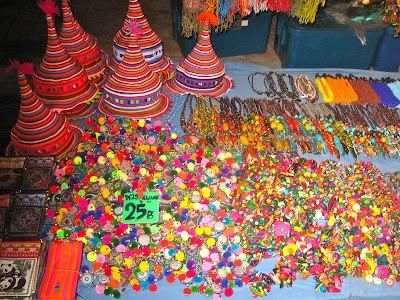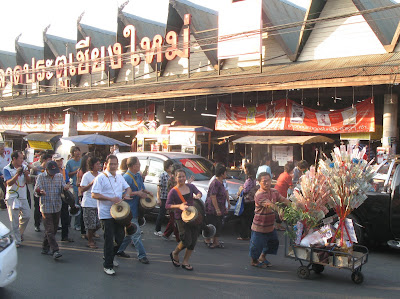 There are probably more places you can get a massage, per square kilometer, in Chiang Mai than anywhere else on the planet. Where throngs congregate, there are bound to be massage chairs set up. No where is this more evident than on the weekends, around the walking markets. And why not? After a couple of hours trudging along narrow congested paths searching desperately for that special item for Aunt Tillie, what would come in handy more than a foot massage?
There are probably more places you can get a massage, per square kilometer, in Chiang Mai than anywhere else on the planet. Where throngs congregate, there are bound to be massage chairs set up. No where is this more evident than on the weekends, around the walking markets. And why not? After a couple of hours trudging along narrow congested paths searching desperately for that special item for Aunt Tillie, what would come in handy more than a foot massage? That's 60 baht for half an hour (about $2.00).
 We were introduced to "fish massage" roughly eighteen months ago in some backstreet marketplace in Siem Reap. More an "attraction" than a massage, it's exactly what travelers seek. "... and here I am at the fish massage". "The What?"
We were introduced to "fish massage" roughly eighteen months ago in some backstreet marketplace in Siem Reap. More an "attraction" than a massage, it's exactly what travelers seek. "... and here I am at the fish massage". "The What?"
 You cleanse your feet, soak them in the tank, and while you're surfing away on the internet, small fish pick away at your feet. Doesn't it just send chills up your spine?
You cleanse your feet, soak them in the tank, and while you're surfing away on the internet, small fish pick away at your feet. Doesn't it just send chills up your spine?
 Thai massage, although relatively new to modern day spa menus, evolved over 2500 years ago. First developed by Buddhist monks in Thailand as a healing modality, it's rapidly become a favorite therapeutic and relaxing pastime for tourists and locals alike.
Thai massage, although relatively new to modern day spa menus, evolved over 2500 years ago. First developed by Buddhist monks in Thailand as a healing modality, it's rapidly become a favorite therapeutic and relaxing pastime for tourists and locals alike.
 The usual "foot massage" doesn't involve any real pain, even though a rounded wooden peg may be jammed into that most sensitive part of your foot. Oil is often involved and the long slow gentle use of pressure may go up as far as your knee.
The usual "foot massage" doesn't involve any real pain, even though a rounded wooden peg may be jammed into that most sensitive part of your foot. Oil is often involved and the long slow gentle use of pressure may go up as far as your knee.
 We were introduced to "fish massage" roughly eighteen months ago in some backstreet marketplace in Siem Reap. More an "attraction" than a massage, it's exactly what travelers seek. "... and here I am at the fish massage". "The What?"
We were introduced to "fish massage" roughly eighteen months ago in some backstreet marketplace in Siem Reap. More an "attraction" than a massage, it's exactly what travelers seek. "... and here I am at the fish massage". "The What?"  You cleanse your feet, soak them in the tank, and while you're surfing away on the internet, small fish pick away at your feet. Doesn't it just send chills up your spine?
You cleanse your feet, soak them in the tank, and while you're surfing away on the internet, small fish pick away at your feet. Doesn't it just send chills up your spine? How much you say? Three one hundred, I was told. I took that to be 300 baht ($11.00) for a full hour of fish picking fun.
 Thai massage, although relatively new to modern day spa menus, evolved over 2500 years ago. First developed by Buddhist monks in Thailand as a healing modality, it's rapidly become a favorite therapeutic and relaxing pastime for tourists and locals alike.
Thai massage, although relatively new to modern day spa menus, evolved over 2500 years ago. First developed by Buddhist monks in Thailand as a healing modality, it's rapidly become a favorite therapeutic and relaxing pastime for tourists and locals alike.Traditional Thai massage is done on a mat or futon laying on the floor. It involves passive stretching and gentle pressure along the body's energy lines to increase flexibility, as well as relieving joint and muscle tension.
 The usual "foot massage" doesn't involve any real pain, even though a rounded wooden peg may be jammed into that most sensitive part of your foot. Oil is often involved and the long slow gentle use of pressure may go up as far as your knee.
The usual "foot massage" doesn't involve any real pain, even though a rounded wooden peg may be jammed into that most sensitive part of your foot. Oil is often involved and the long slow gentle use of pressure may go up as far as your knee.After a two hour, four hands, herbal compress, oil massage, you will indeed be a new person.
Yes, sign me up indeed.
The Thai Herbal Compress (Luk Pra Kob) contains up to twenty traditional Thai herbs including Camphor, Kaffir lime, Lemon Grass, Galanga, Tamarind leaves, Prai Ginger Zingiber, Cassumunar, Cinnamon, Turmeric oil, and Aromatic Salisb.

.jpg)































